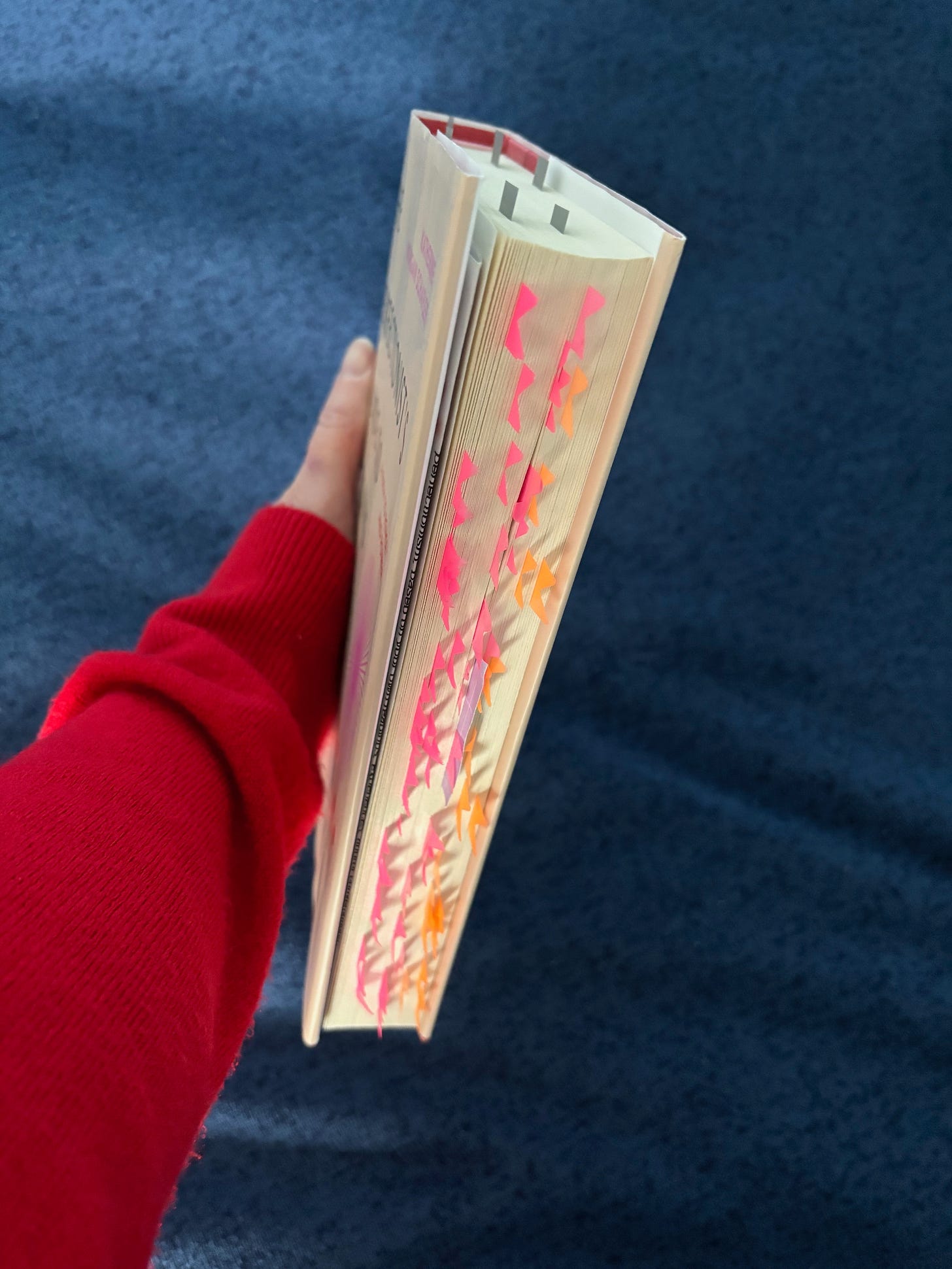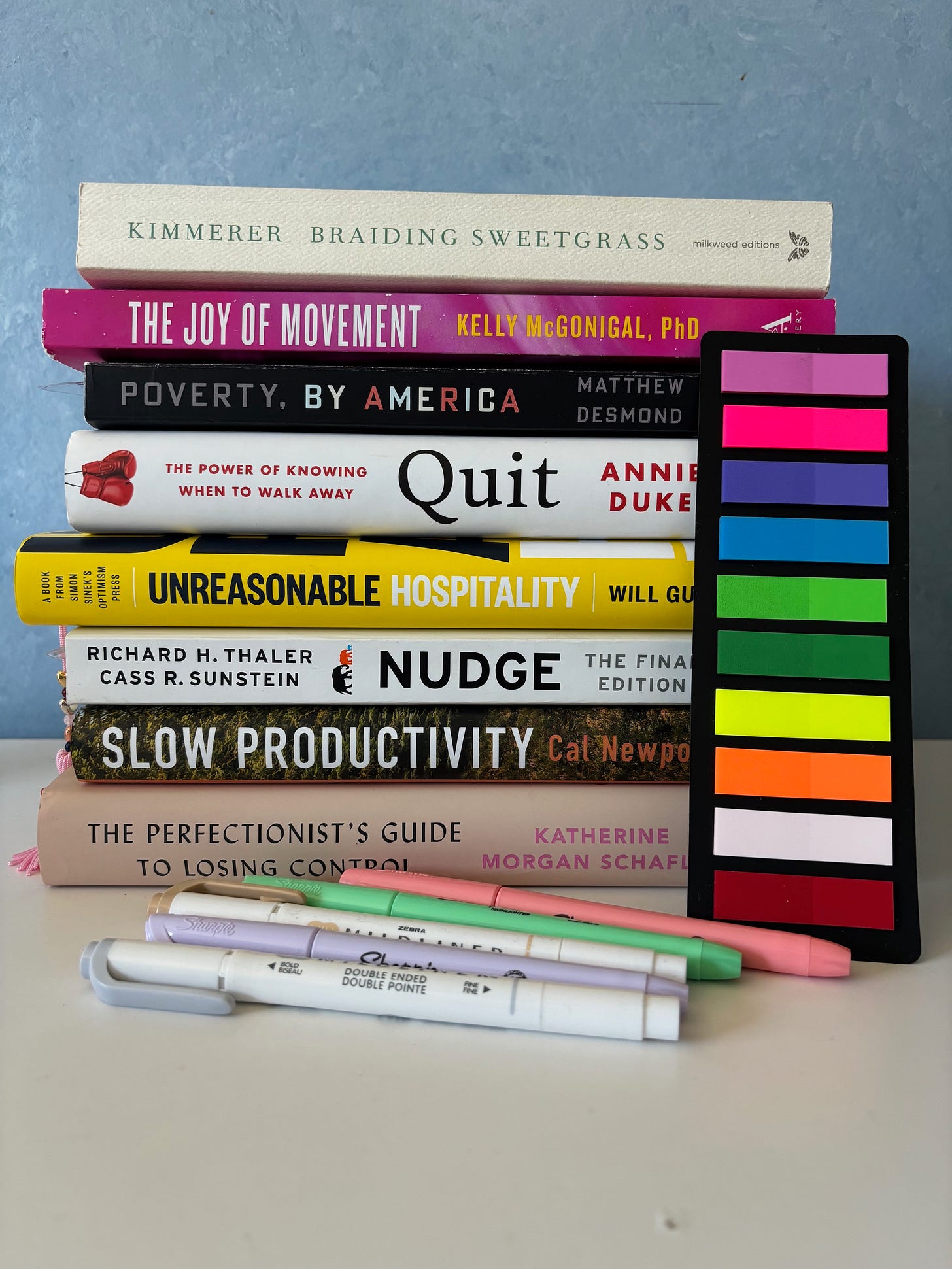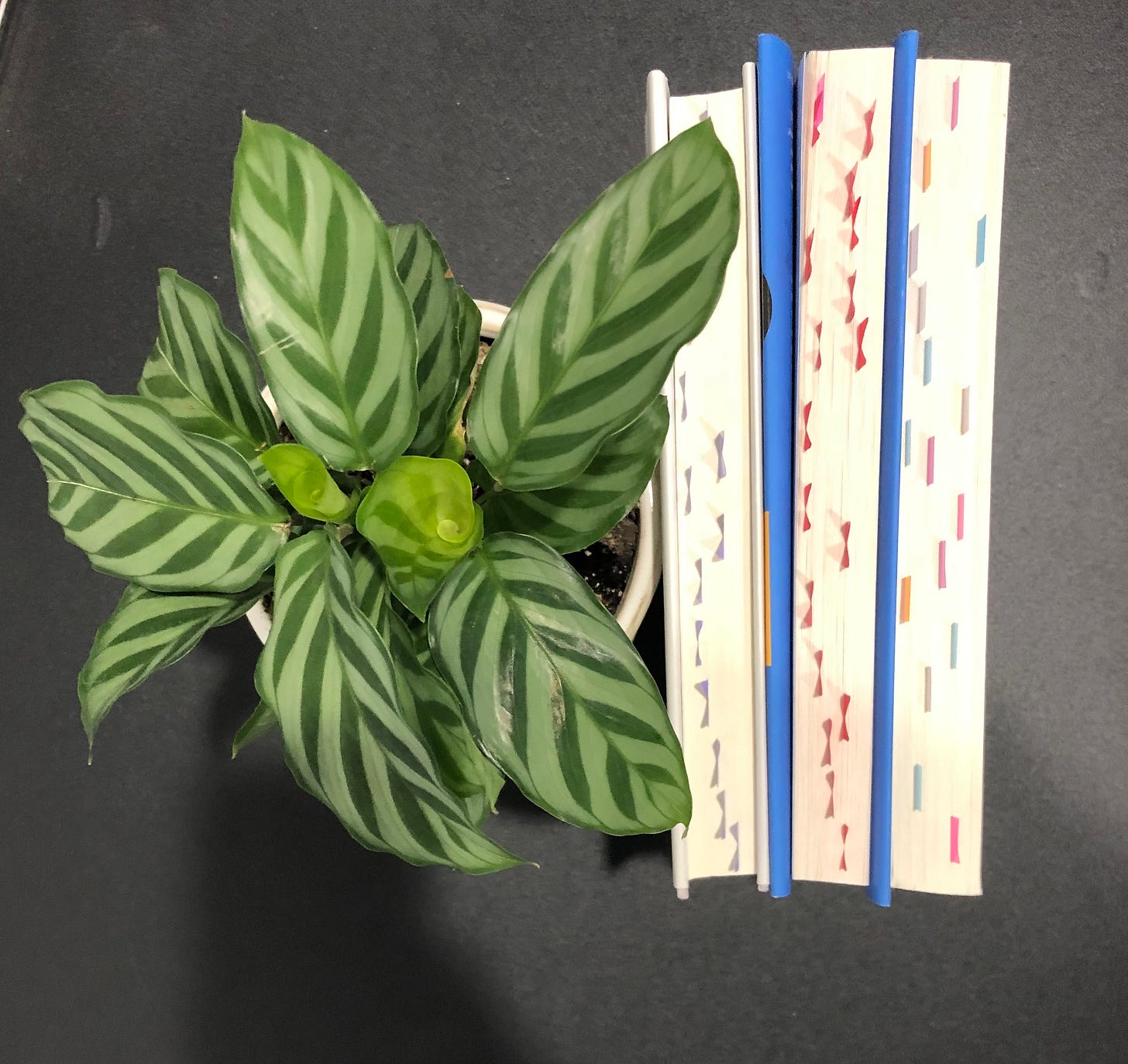How I Annotate My Books
The tools, systems, and overall way I nerd out when annotating while reading.
I’ll be honest, annotating books while I read them has become so second-nature to me that I can’t imagine not doing it. Lately, however, I’ve received multiple questions about my process: How do I annotate? What do I choose to highlight and/or tab? Do I actually refer back to my annotations? Why do I bother?
I’m sure I probably annotated to some extent in high school, and I definitely recall doing so in college. (I was also oddly fascinated, when purchasing used textbooks, by what other people had chosen to highlight before me!) But it was in graduate school - with the extensive amount of reading, recalling, data compilation, writing, and so on that my doctorate degree required - where I realllllly honed my annotating process. This was before so much was easily accessible online, but I now use many of the same principles with digital annotating as well.
In today’s article, however, I will primarily focus on how I annotate paper books. I will ‘spill the tea’ (ha ha, none of this is a big deep secret!) on all things annotating. My heftiest annotating tends to come with nonfiction reading, so that’s what I’ll discuss here, but much of what I’ll share is easily transferred to fiction reading, too.
Whether you are new to annotating or have been doing it in some form for years, I hope you find value here! Feel free to ask any questions in the comments below, and please also share tips and ideas that you find helpful when annotating.
Time to pull out our favorite highlighters and begin!
Why Annotate?
Let’s start where I pretty much always do: with purpose. Why annotate at all?
I annotate for both professional and personal reasons.
Professionally, I frequently write online and elsewhere, coach achievers (many of whom are readers themselves), and lead various coaching and book groups. When I am sharing a concept that I learned while reading, I want to a) credit the source, and b) let my readers / clients / book club members know where to go for more. Also, when an author phrases an idea in a powerful or poignant way, I want to be able to share it in their words, and annotating helps me do this easily.
On the personal side, I find that annotating helps me engage more deeply with the text, retain information and details better, and stay more focused while reading. I also find it so enlightening to look through what I considered important enough to highlight when I first read a book - often when I was in a different phase of life - compared to what stands out as important to me when I flip through the pages years later. The experience of connecting with the writing in this manner has supported my personal growth in tremendous ways, whether or not I incorporate the book directly into my work.
I’d encourage you to ask yourself the question, too: Why do you want to annotate? Because ultimately, you engage in the process (or choose not to) for you, and your answer can inform how you go about annotating as well.
Annotation Tools
First off, these tools are completely optional. All you really need is a pen or some way of marking what you want to refer back to. Like with bookmarks, you can use whatever you have handy - in a pinch, I’ve annotated with a shredded paper napkin! What’s listed below are just my current favorite tools of the annotating trade.
(Warning: I’m about to get real nerdy here!)
Highlighters. Back in my college days, the only highlighters I recall being available were neon bright and offered in about six colors. Now our options are plentiful! My current favorites are Mildliners - they come in a multitude of colors and are double-tipped, with a broad side for traditional highlighting and a narrow side for underlining.
Page tabs/flags. These have become the bread-and-butter of my annotating system. Like highlighters, they come in an abundance of colors and styles. I use quite a variety (you can see examples in the photos throughout this article), and have especially come to appreciate ones with a transparent or see-through quality; that way, when I go back to a line, I don’t have to remove the tab to see what word(s) it is covering.
Pen and/or pencil. For writing in margins or on sticky notes (more on this below), although some people also prefer to underline in pen vs. highlight. Personally, I’ll nearly always choose pen over pencil, for the boldness and longevity. I also do crossword puzzles in pen, so maybe there’s a connection there?
Sticky notes. While I suppose my page flags are also a version of sticky notes, here I am referring to a pack of 3” x 3” ones. I will often pull a small portion (ie, a dozen or so) off the full stack and adhere them right into the inside front or back cover so they’re easily accessible.
Study book. Sometimes referred to as a commonplace book or reference notebook, I heard Catherine from the Sterling Ink planner company call hers a ‘study book’ last year and that has stuck with me. Basically, I use my study book to capture thoughts, quotes, concepts, and so on from the book I’ve just read. This allows more space than a sticky note, and the rewriting of certain concepts in my own handwriting helps solidify ideas in my brain. You can use any notebook for this; for my fellow stationery nerds curious about my specific study book, I’m currently using a ruled Leuchtturm1917, A5 size.
On a related note, the study book is my main tool when I listen to audiobooks. I’ll use the bookmark feature in Libby and LibroFM as I’m reading, then revisit those portions and note them in my study book before deleting the audio from my phone.
What To Annotate
So what exactly do I highlight, tab, underline, and write?
This is a bit tricky to define, because it’s basically anything that moves me in some way or that I think I’ll want to refer back to in the future. Some examples:
Concepts around which the book is crafted. I’m currently reading How To Winter by Kari Leibowitz, for instance, and I have tabbed the early section where she shares a brief overview of her research and why she decided to study the topic in the first place.
Descriptions or definitions that provide an important foundation for the book (or for a word/concept with which I am unfamiliar).
Items that would make great book club discussion points.
Powerful sentences - whether they’re beautiful, poignant, moving, infuriating, clarifying, or meaningful. I will often share a couple of these in my reviews as well as revisit them for a boost of insight.
New ideas to share that could benefit clients, family members, friends, workshop participants, or others.
Citations of other books or resources that I may also want to seek out.
A different perspective or unique way of looking at an issue.
I use the pen to make notes either in the margins or, more commonly for me nowadays, on sticky notes. I’ll jot down why something stands out for me, why I agree or disagree with a statement, how what I’m reading connects to something else I’ve read, or basically any thoughts that come to mind while I read. If you record these things on sticky notes vs. in the margins, it makes it easy to remove your notes if you then lend, donate, or resell your book at some point.

When it comes to color-coding, I tend to opt out - mostly because it makes the system more complex, and I am a big fan of simplicity. I used to color-code more often, but then I’d become stymied when the pink highlighter ran out of ink or I used up all the yellow tabs before I finished reading. (The shock! The horror!) So now, I typically grab one or two highlighters and a bookmark with page flags and I’m good to go.
I do know some people who love color-coding, however, using one color for quotable sentences, another for information on a particular topic, a different color for a different topic, and so on. Whatever serves you best, do that! And figuring that out may take some experimentation along the way.
And this is the teeniest detail, but people have asked me about it so I do want to mention it: I like to place my page tabs far enough into the page so they are flush with the outside cover. This prevents them from getting all bent up when they’re in my bag or on my bookshelf. And if you tab as much as I did in The Perfectionist’s Guide To Losing Control by Katherine Morgan Schafler (the above photo), for example, it also makes a satisfying noise to run your hand down them all! (I warned you this would get nerdy!)
Annotating Without A (Permanent) Trace
Perhaps you primarily read library books, or books borrowed from friends or family members. Or maybe you own your books but want to keep them in pristine condition. Can you still annotate?
Definitely! But with a few tweaks, because we do not (I repeat, we do not!) want to write in library books or mark them up in any way.
I nearly always start my reading with a library copy, only purchasing the book for myself if I discover I’m wanting to highlight frequently or I realize it’s a book I will wish to refer back to regularly. If I’m just noting a few things here and there, this is what I primarily use:
Study book. Used in the same way as mentioned above.
Page tabs. And take extra care (ie, do a test run on a different piece of paper) to ensure they are high-quality and don’t remove ink from the page when removing the page tab itself.
Larger sticky notes. I have a set of 4” x 6” sticky notes, and I’ll put one or two on the inside front cover of my library book; there, I can jot down thoughts, page numbers, a periodic quote, etc. for easy access later. In a recent book I read, I made notes about my reading experience there - “I love the actual content but wish the author wasn’t trying so hard to be funny” - so I could remember it when I wrote my summary. You can also use a regular piece of paper for this; I like the sticky note because it doesn’t fall out. (Just remember to remove it, and everything else, before returning your book!)
Isn’t This All A Bit … Much?
“So, let’s say you go to a coffee shop to read. Do you lug around all this equipment with you, too?”
Well, yes. But to clarify, nearly ‘all this equipment’ fits into the cute little pen pouch pictured below, so it’s really not a burden.
And sometimes I just go with my book, using a bookmark with page flags stuck right on it, and I’m set. Like with many things in life, you can make as much or as little of it all as you’d like.
(Also, if there’s anything I’m ‘a bit much’ about, it’s probably books and reading, and I am perfectly o.k. with that! :-))
Ready To Start Your Own ‘Adventures In Annotating’?
A word to the wise: Don’t feel the need to do all of this, or all at once. While I’m reading, I usually only have my highlighter out to capture things in the moment but continue my reading flow. At the end of a chapter or reading session, I’ll go back and add page tabs. I typically don’t update my study book until I’ve finished reading the entire book.
This is primarily to immerse myself as fully as possible into my reading flow. Pausing to highlight, and then to add a tab, and then to update my study book, and then … well, you get the idea. If I have an hour to read, I want to spend the majority of that time actually reading, then maybe reserve the last five minutes for tabbing and such.
This is also why I prefer these methods over taking photos or recording items in the notes app of my phone: If at all possible, I’d rather not have my phone with me while I read. The risk for distraction is just too ever-present there.
Again, this - all of this - is just my personal preference. You do what works for you! And hopefully you’ve picked up an idea or two here to try.
A Final Thought
When I sat down to write this article, I honestly thought it would take a matter of minutes and end up incredibly short. Now that I’m wrapping it up, I think it is one of the longest articles I’ve written here to date! Who knew we’d have so much to talk about when it comes to annotating books?!!
On a side note, if you’ve read this far, I really think you’d enjoy participating in our Reading And Purpose Nonfiction Book Club! This is an added benefit for paid subscribers and we’re discussing highly-annotatable books throughout 2025. :-) Upgrade your subscription if you’d like to join us!
One final thought: Reassess your system from time to time. What’s working well? What feels cumbersome? What are you noticing with your retention, your process, your reading enjoyment?
Refine and readjust as you go. Soon, you’ll be adding ‘master annotator’ to your list of skills and strengths! Or at least hopefully having fun with the process while enhancing your reading and reflection experiences.
Do you annotate your books? What do you incorporate into your process that I haven’t mentioned? Are there certain types of books you’re particularly drawn to annotating? Share your experiences, questions, and helpful hints in the comments - I’d love to hear!
Note: You can find Part 2 to this article here!
Questions? Comments? Books or topics you’d like me to discuss here? Feel free to email me at readingandpurpose (at) gmail (dot) com or comment on this post directly in the app/website. I love hearing from you and I appreciate your support!








Such great tips for library books. We often have a 'note' set up in our phones, but you're right, the distractions are too many! Going to incorporate the large sticky notes into our routine
How do you tab books? What are their purpose? I'm trying to start tabbing my books and I don't know how to do it lol. Also, what is difference between tabbing and highlighting? Doesn't tabbing contradict highlighting?